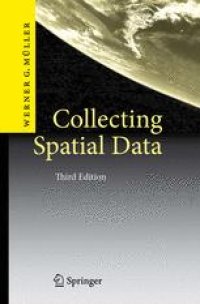
Ebook: Collecting Spatial Data: Optimum Design of Experiments for Random Fields
- Tags: Regional Science, Statistics for Engineering Physics Computer Science Chemistry & Geosciences, Math. Appl. in Environmental Science, Math. Applications in Geosciences, Statistics for Business/Economics/Mathematical Finance/Insuranc
- Year: 2007
- Publisher: Springer-Verlag Berlin Heidelberg
- Edition: 3
- Language: English
- pdf
The book is concerned with the statistical theory for locating spatial sensors. It bridges the gap between spatial statistics and optimum design theory. After introductions to those two fields the topics of exploratory designs and designs for spatial trend and variogram estimation are treated. Special attention is devoted to describing new methodologies to cope with the problem of correlated observations. A great number of relevant references are collected and put into a common perspective. The theoretical investigations are accompanied by a practical example, the redesign of an Upper-Austrian air pollution monitoring network. A reader should be able to find respective theory and recommendations on how to efficiently plan a specific purpose spatial monitoring network. The third edition takes into account the rapid development in the area of spatial statistics by including new relevant research and references. The revised edition contains additional material on design for detecting spatial dependence and for estimating parametrized covariance functions.
The book is concerned with the statistical theory for locating spatial sensors. It bridges the gap between spatial statistics and optimum design theory. After introductions to those two fields the topics of exploratory designs and designs for spatial trend and variogram estimation are treated. Special attention is devoted to describing new methodologies to cope with the problem of correlated observations. A great number of relevant references are collected and put into a common perspective. The theoretical investigations are accompanied by a practical example, the redesign of an Upper-Austrian air pollution monitoring network. A reader should be able to find respective theory and recommendations on how to efficiently plan a specific purpose spatial monitoring network. The third edition takes into account the rapid development in the area of spatial statistics by including new relevant research and references. The revised edition contains additional material on design for detecting spatial dependence and for estimating parametrized covariance functions.
The book is concerned with the statistical theory for locating spatial sensors. It bridges the gap between spatial statistics and optimum design theory. After introductions to those two fields the topics of exploratory designs and designs for spatial trend and variogram estimation are treated. Special attention is devoted to describing new methodologies to cope with the problem of correlated observations. A great number of relevant references are collected and put into a common perspective. The theoretical investigations are accompanied by a practical example, the redesign of an Upper-Austrian air pollution monitoring network. A reader should be able to find respective theory and recommendations on how to efficiently plan a specific purpose spatial monitoring network. The third edition takes into account the rapid development in the area of spatial statistics by including new relevant research and references. The revised edition contains additional material on design for detecting spatial dependence and for estimating parametrized covariance functions.
Content:
Front Matter....Pages i-xii
Introduction....Pages 1-10
Fundamentals of Spatial Statistics....Pages 11-42
Fundamentals of Experimental Design....Pages 43-76
Exploratory Designs....Pages 77-99
Designs for Spatial Trend Estimation....Pages 101-139
Design and Dependence....Pages 141-172
Multipurpose Designs....Pages 173-191
Back Matter....Pages 193-242
The book is concerned with the statistical theory for locating spatial sensors. It bridges the gap between spatial statistics and optimum design theory. After introductions to those two fields the topics of exploratory designs and designs for spatial trend and variogram estimation are treated. Special attention is devoted to describing new methodologies to cope with the problem of correlated observations. A great number of relevant references are collected and put into a common perspective. The theoretical investigations are accompanied by a practical example, the redesign of an Upper-Austrian air pollution monitoring network. A reader should be able to find respective theory and recommendations on how to efficiently plan a specific purpose spatial monitoring network. The third edition takes into account the rapid development in the area of spatial statistics by including new relevant research and references. The revised edition contains additional material on design for detecting spatial dependence and for estimating parametrized covariance functions.
Content:
Front Matter....Pages i-xii
Introduction....Pages 1-10
Fundamentals of Spatial Statistics....Pages 11-42
Fundamentals of Experimental Design....Pages 43-76
Exploratory Designs....Pages 77-99
Designs for Spatial Trend Estimation....Pages 101-139
Design and Dependence....Pages 141-172
Multipurpose Designs....Pages 173-191
Back Matter....Pages 193-242
....